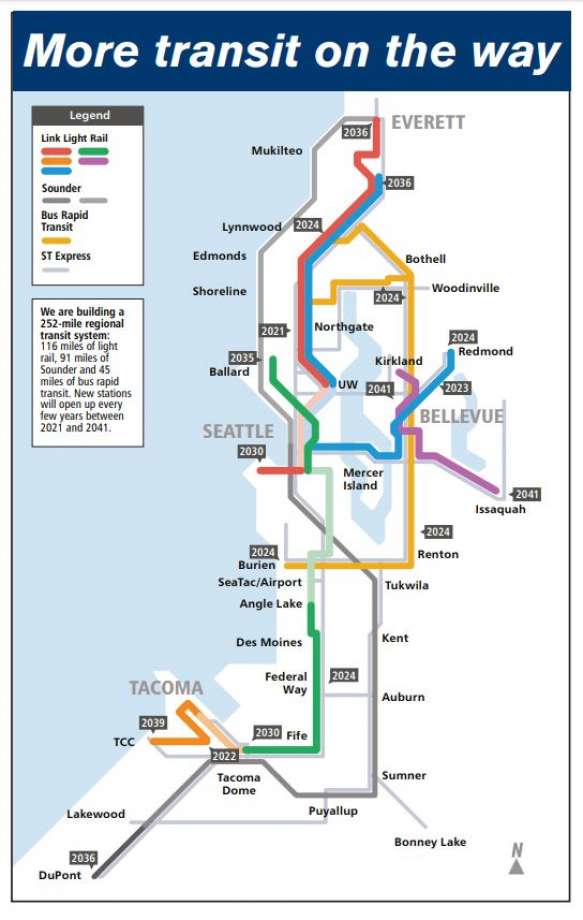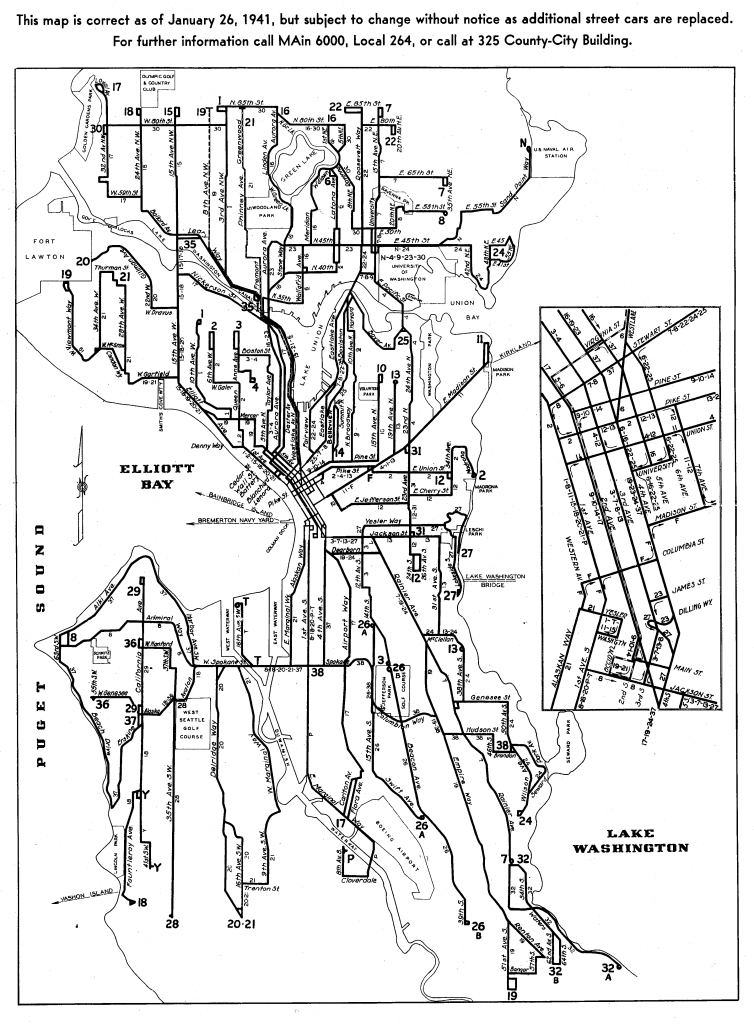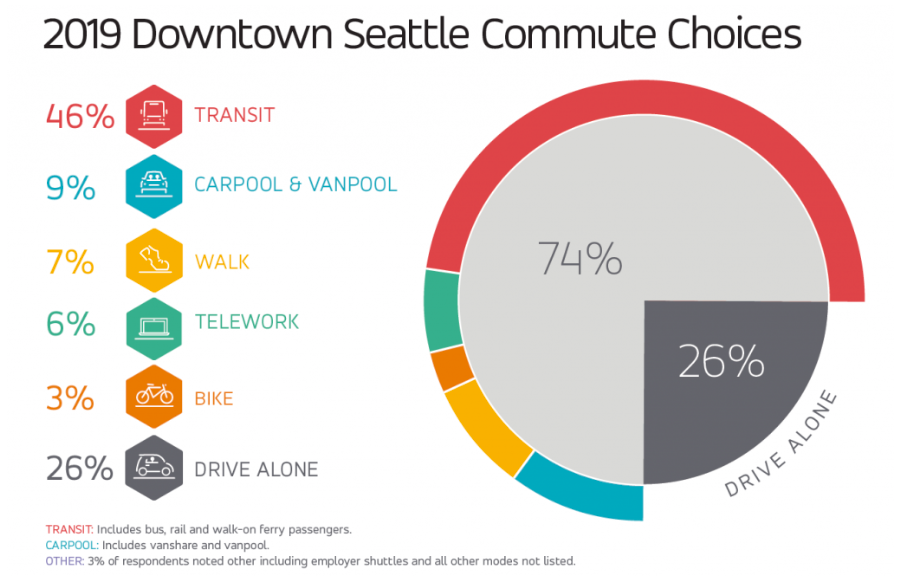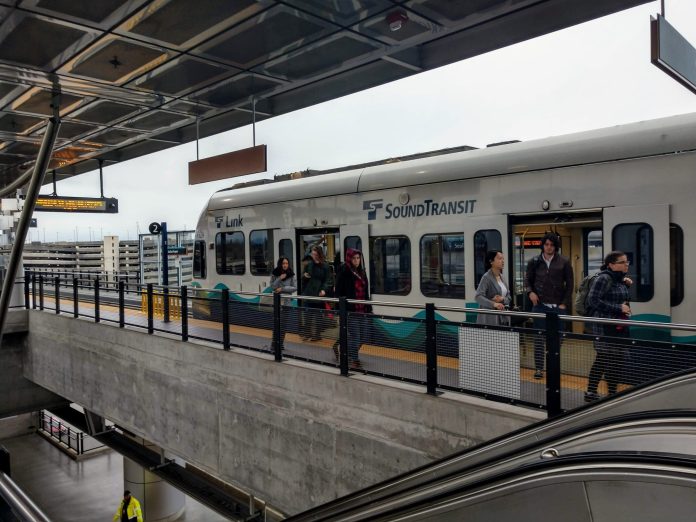An idea is going around, particularly in conservative circles, that the Covid pandemic fundamentally changes transportation needs and behooves Seattle to cancel its transit expansion plans. These ideas are built on a basic misunderstanding of cities, society, and geometry; they should be discarded.
On Monday, Puget Sound Business Journal published an op-ed from Mariya Frost plying the “let’s abandon transit” case. Frost works at the conservative think-tank Washington Policy Center and has long been grinding an axe against light rail projects. Her critiques are easily refuted.
Pre-Covid, mid-Covid, or post-Covid, transit is the backbone of our transportation system. Seattle’s ambitions of growth and high quality of life–things the Puget Sound Business Journal normally champions–only work if transit lays the groundwork. Highways can’t be widened fast enough even if we did want to waste all that money and lock in all those climate emissions and sprawl. Autonomous vehicles don’t change the basic geometry of cities. If you want the city to be dominated by places rather than parking lots, private vehicles and ridehailing cannot be your focal point, autonomous or otherwise.
“Four years ago, transportation experts predicted Sound Transit’s light rail expansion would be obsolete before it’s built,” Frost begins her piece, with “experts” referring primarily to her own think-tank and Republican leaders. Already granting herself victory in re-litigating her failed Sound Transit 3 (ST3) argument, she adds Covid only “accelerated trends that were already happening.”
Claiming voters only passed ST3 out of desperation to improve their commute–heaven forbid–Frost launches in the central transportation argument: let them eat buses. “Officials plan to spend billions to send light rail to low-density suburban areas despite better alternatives like Bus Rapid Transit (BRT), which is more flexible and less expensive.”
Never mind that ST3 funded 54 miles of BRT along with 64 additional miles of light rail. How would buses better serve Ballard and Uptown? Those neighborhoods already RapidRide D, a version of BRT-lite, and don’t actually seem satiated by it. Likewise, Tacoma wanted a light rail connection to the airport beyond the express buses they already have, the same goes for Everett.

“It is time for a Sound Transit reset,” Frost continues. “Planners should stop developing 20-year transportation plans when our future is so unknown.” She proceeds to make an argument that working from home in mass numbers is a lasting deep-rooted phenomenon, despite that being the most knee-jerk conclusion to draw from Covid. People would rather work from home than contract a deadly virus in the office, but it seems foolish to assume that’s immutable once a vaccine is available. And it’s already not the reality for the essential workers that make up one in three transit riders. More to the point, tons of transit trips aren’t work commutes anyway.
The next erroneous claim is that light rail is failing to “attract companies.” The example she cites is REI selling its shiny new headquarters to Facebook. She fails to note that REI pocketed a handsome profit in the process–light rail was a big reason why it could flip its headquarters so easily. A suburban office park on a lonely highway may have been a different story.
Onward to some inflexible thinking: “Light rail is inflexible, while decisions about real estate, as well as the choices people make about where they live and work, are dynamic.”
If this were true, we’d find buses abandoning old transit corridors all the time and pioneering new ones on a regular basis. In reality, that rarely happens and most of Seattle’s busiest buses are the old streetcar routes of the past. If you look at the 1941 streetcar map below, you’ll notice that almost all the streetcar routes continue to be major bus routes 80 years later. Untethered from rail, buses could have went wherever. They didn’t. A good transit corridor lasts no matter the technology because people settle around it and build beautiful places that endure even as they take on new life in each generation.

People continue to live and work in the same corridors a century later. Cities are dynamic, but not in the way Frost imagines. Adapting and building on the infrastructure of the past is what makes cities dynamic, not running a bus out to some cul-de-sac and abandoning a perfectly good transit corridor.
Moreover, once a bus reaches BRT level, it becomes even less mobile than Frost suggests because moving it would involve abandoning high quality bus stations, station access improvements, dedicated bus lanes, and upgraded traffic signals with transit priority and implementing them on a new corridor. To get all these things right, high quality BRT can be nearly as expensive as light rail–I-405 BRT is a billion-dollar-plus project that will spend $260 million on one mega interchange alone. Unless of course Frost is proposing BRT creep, a common phenomenon where a really high quality rapid bus is promised and a much lower quality slower bus is delivered.
While Frost pretends transit-oriented development suddenly stopped being a thing this year, almost every major development in the region continues to be tied to transit nodes–U District, Roosevelt, and Northgate have seen a huge wave of development ahead of light rail reaching them next year. “Expanding an increasingly antiquated $100 billion-plus fixed rail system is not a good use of public money, especially post-Covid. Working from home was popular in the U.S. before the pandemic hit, overtaking transit ridership for the first time in 2017.”

Again Frost seems to invent a statistic. Transit ridership may be rather low looking at the whole United States (counting rural and suburban areas with very limited transit options), but in Seattle it’s quite high. Commute Seattle’s annual Downtown survey that 46% of workers used transit in 2019, compared to 6% teleworking. Walking to work outperformed teleworking at 7%. Regionwide, transit’s mode share sits at 23%, which compares favorably to most American cities (save for New York) and far exceeds teleworking in normal circumstances. Frost can try to obscure the matter, but the reality on the ground is transit is far more popular than her tortured statistics let on.
“Competing technological innovations in transportation are announced daily,” Frost announced, which is patently false. Even if you believe snake-oil salesmen like Elon Musk, their new ideas aren’t that frequent–nor are they as revolutionary as billed. And Musk recently revealed Boring Company–billed as the future of transit–was “basically just Teslas in tunnels” and his Las Vegas Hyperloop was delivering a fraction of the promised capacity. Likewise, autonomous cars have long been just around the corner and could be a lot longer away and far less revolutionary than the hype.
Despite the car industry spending billions on advertising, Frost is frothing mad that Sound Transit spent $900,000 on ads. “In an effort to convince the public to ignore these trends, last year transit officials spent nearly $900,000 on bizarre ads promoting light rail as the future of travel. The ads, featuring people struggling to take off with jet packs, appeared on social media with the slogan.”
Flying cars and jet packs may have been some of the “innovations” she alluded to in the previous paragraph, so maybe she’s just hurt that they’re being trivialized. And you’ll notice ads are never taken as a sign of weakness for a car company despite the massive volume. Why don’t cars sell themselves if they’re so great? Perhaps, Frost is on to something here–Seattle is leading the nation in reducing its car ownership rates. Maybe cars aren’t actually that useful in cities, so car companies come up with lifestyle brands to make us think they’re indispensable? Is Ford selling sports utility vehicles and heavy duty trucks or are they selling an overpriced cure for male insecurity?
Sensing the weakness of the argument so far, Frost invents some more statistics suggesting transit primarily serve higher-income workers. “As Sound Transit officials ignore innovation in how people choose to live and travel, taxpayers continue to pay for a light rail system that fails to serve those with the fewest options. Census Bureau statistics reveal that more Seattle-area workers making over $75,000 commute by transit than those making under $25,000. Sound Transit is building a system for higher-income workers who often can work from home, while those most disproportionately impacted by Sound Transit’s taxes are less likely to use the system.”
This is very wrong. Part of it is math. The median household income in King County is more than $100,000. There are far more workers making more than $75,000 than less than $25,000 in the region so her comparison tells us almost nothing about the rates of transit use by income. In reality, low-income folks are the most reliant on transit, particularly in a pandemic setting when many high-income office workers are working from home or driving.
It also wrong because the “disproportionately impacted” part ignores that Sound Transit has among the most progressive tax mix of any taxing authority in the state. Sound Transit’s motor vehicle excise tax is highly progressive, hitting high-value cars much harder than older low-value cars. The other primary tax is property taxes, for which low-income homeowners can apply for an exemption and which tenants don’t pay directly.
Ending with a bang, Frost suggests Sound Transit didn’t build enough park-and-rides, despite it investing hundreds of millions on them. Plus, she suggests park-and-rides are somehow efficient while costing $80,000 or more per space to get one daily rider each. Likewise, private sector partnerships she pined for haven’t panned out that well; the shuttle services Ride2 provided fizzled out due to high costs and mediocre ridership.
Covid is a dramatic challenge, but we shouldn’t act like the pandemic will last forever. Sound Transit will create an estimated 223,000 new jobs building out ST2 and ST3. Abandoning that would send our region into a tailspin and deepen the recession. We must plan for our nation-leading transit ridership growth and economic growth to return like it was before this crisis. We should be accelerating rapid transit expansion to curb climate emissions rather than be contemplating cuts. Cities still run on transit despite what Republican lobbyists and snake-oil salesmen try to tell you.
Doug Trumm is publisher of The Urbanist. An Urbanist writer since 2015, he dreams of pedestrian streets, bus lanes, and a mass-timber building spree to end our housing crisis. He graduated from the Evans School of Public Policy and Governance at the University of Washington in 2019. He lives in Seattle's Fremont neighborhood and loves to explore the city by foot and by bike.


